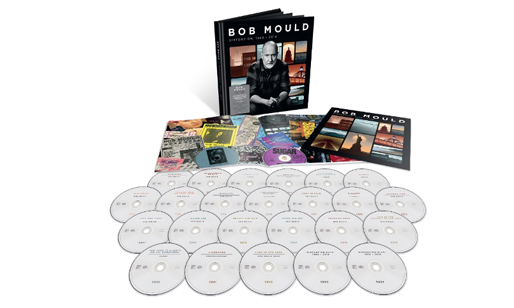Bob Mould Anthology To Feature Nearly 300 Tracks

After Hüsker Dü disbanded in 1988, singer-guitarist Bob Mould went on to release some terrific albums with Sugar and as a solo artist. Due out Oct. 23, Distortion 1989-2019, compiles for the first time the entirety of Mould’s recorded work from 1989 onward: 18 studio albums, plus four live albums and two albums of rarities and collaborations.
Assembled with Mould’s full involvement and featuring new sleeve notes from UK music critic Keith Cameron, the set features exclusive new artwork, this is the definitive portrayal of an American rock icon.
“It’s called Distortion because it describes the music and it fits the world we live in,” says Mould in a press release. “In this new age, everybody shares their life in real time. But I’m not done yet. If I didn’t have a constantly active career, this anthology might feel like the proverbial dirt landing on top of my coffin — though somehow I seem to be able to crawl my way out of the dirt every time!”
To help build anticipation for the release, Mould has released a live recording of “Could You Be the One?,” a Hüsker Dü classic, drawn from the trio’s 1987 swansong Warehouse: Songs and Stories. It’s included on the anthology.
“For years, I didn’t play Hüsker Dü material with my subsequent touring bands,” says Mould. “This was the first time my longtime friend and colleague [bassist] Jason Narducy played in my touring band. [Keyboardist] Rich Morel was my work partner for 11 years in BLOWOFF, and the 9:30 Club was home for our monthly dance party. [Drummer] Brendan Canty nudged me out of my self-imposed ‘rock retirement’ after the 1998 Last Dog and Pony Show tour [which is also chronicled in the box set]. Brendan’s company Trixie Productions filmed and edited the show.”
Distortion’s 24-CD box set edition features 295 tracks, mastered by Jeff Lipton and Maria Rice at Peerless Mastering in Boston, and includes every solo album from 1989’s Workbook to 2019’s Sunshine Rock, the entire Sugar catalogue, Mould’s long out-of-print electronica projects LoudBomb and Blowoff, and four live albums spanning the period 1989-2008. Also included is Distortion Plus: 1989-2019, a new and exclusive collection of rarities and collaborations, featuring such highlights as “Dear Rosemary,” Mould’s 2011 collaboration with Foo Fighters, his fabled Golden Palominos contribution “Dying From The Inside Out” and a previously unreleased demo version of “Dog on Fire,” his theme tune for Comedy Central’s The Daily Show.

Illustrator Simon Marcher created the artwork, and the 72-page booklet features sleeve notes by Cameron, new interviews with Mould, a foreword by writer and actor Fred Armisen, testimonials by Richard Thompson, Shirley Manson and Best Coast’s Bethany Cosentino, plus lyrics and unseen memorabilia. A 1,000-limited edition includes an exclusive print hand-signed by Bob himself.
The vinyl edition contains eight LPs, beginning with Workbook through to the final Sugar studio album, File Under: Easy Listening, plus Besides, Sugar’s compilation of B-sides and non-album tracks and Distortion Plus: 1989-1995, a new and exclusive collection of rarities and collaborations. Each album is mastered by Jeff Lipton and Maria Rice and features new Marchner artwork; the 28-page companion booklet features new sleeve notes plus lyrics and memorabilia, and a 750-limited edition includes a 12”x12” screen print of the new Copper Blue artwork, hand-signed by Marchner and Mould.
Truly then, this is the definitive guide through the career of one of the most storied, creative and consistent voices in the American underground. As Cameron offers:
“In 1989, Bob Mould was already a renowned figure, thanks to his trailblazing work with Husker Dü, the Minneapolis trio which refracted ’60s pop melody through the discord of hardcore punk, creating a new language that Pixies and Nirvana would subsequently teach the world to sing,” says Cameron in press materials.
In 1992, Mould formed Sugar, and the band stormed out the gates with its noisy debut, Copper Blue. Mould would then go in a completely different musical direction with his next solo album.
“Just three years later, with Sugar at its commercial peak, Mould ended the band and made a self-titled solo record mapping the most nakedly personal path down a road already hallmarked by unsparing self-expression,” says Cameron. “He shocked then confounded fans by announcing his retirement from rock music in 1998 and re-emerging in the new century as an experimental electronica artist and successful DJ, whose club night Blowoff became a phenomenon across the US. By the end of the ’00s, Mould had found a harmonious accommodation between his musical selves, and in 2012 released the catalytic Silver Age, made with his latest power trio configuration, and heralding a resurgent decade. A succession of albums up to 2019’s Sunshine Rock followed, each one a real time/real life distillation of fearless artistic vision and a master craftsman’s skill.”
Photo: Blake Little Photography







